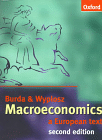Monetary History : Commented BibliographyThe Bimetallic Standard | The Crime of 1873 | François Micheloud's Homepage |
||
In white, my recommended book. Clicking on the titles will bring you to an online bookshop
|
||
BAUM, FRANK, 1900, The Wonderful
Wizard of Oz, George M.Hill : Chicago
|
||
| BURDA, M., WYPLOSZ, C., 1993, Macroeconomics, a European Text, Oxford UP : Oxford ..
|
||
FLANDREAU, M., 1996 a, The Gradient of a River :
Bimetallism as an Implicit Fluctuation Band, Unpublished paper given by prof. Wyplosz
FLANDREAU, M.., 1996 b, Adjusting to the Gold Rush : Endogenous Bullion Points and the French Balance of Payments 1846-1870, Explorations in Economic History 33, 417-439
|
||
| FRIEDMAN, M., 1992, The Crime of
1873, in Money
Mischief, Harcourt Brace : NY, pp 51-80 FRIEDMAN, M., 1992, Estimating the Effect of Continuing Bimetallism after 1873, in Money Mischief, Harcourt Brace : NY, pp 80-104 FRIEDMAN, M., 1992, William Jennings Bryan and the
Cyanide process, in Money Mischief, Harcourt Brace : NY, pp 104-126 |
||
. |
||
| FRIEDMAN, M., and SCHWARTZ, A., 1963, A Monetary History of the United States, 1867-1960, Princeton UP :
Princeton, pp 89-135 . |
||
GLAD, P.V., 1991, Mc Kinley, Bryan, & the People, éd.orig. Lippincott : NY
GREEN, T., 1993, The World of Gold, Rosendale Press : London
|
||
| GREIDER, W., 1987, Secrets of the Temple : How the Federal Reserve Runs the Country
, Simon and Schuster : New-York, pp 275sq . |
||
GROSSMAN, R.J., and ROSS, E.D., 1996, Gold Bugs versus Silver Fish, in Friends of Financial History, Issue 57 Fall 1996, The Museum of Financial History : NY, pp 20-27
HALIMI, S., 1996, Le populisme, voilà l’ennemi !, in Le monde diplomatique No 505 Avril 1996, Le Monde : Paris, p.10
KORTEWEG, S., and KEESING, F.A.G., 1959, A Textbook of Money, Longmans : London, pp 5-10
ROCKOFF, H., 1990, The Wizard of Oz as a Monetary Allegory, in Journal of Political Economy 98 (August 1990) pp 793-60
Illustrations : Pictures I use in my slides were either scanned directly from the books herafter or from the wonderful collection of www.arttoday.com.
|
||



